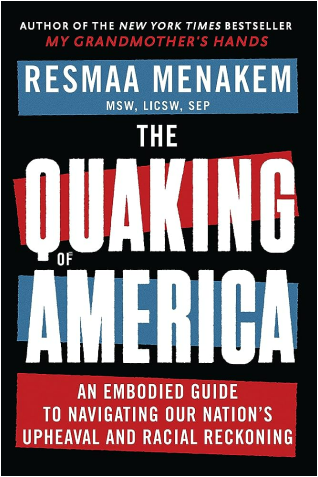
Photo credit: Andrea Piacquadio
You will need to commit yourself—and your efforts will cost you something
KEY POINTS:
- White bodies can help usher in a living, embodied anti-racist culture.
- This involves an emergent process—and a lifelong commitment.
Imagine that your six-year-old daughter says to you at supper, “Being an adult looks hard. Tell me what to do to become one.”
Your answer won’t be a checklist. Instead, you might say, “Well, butter bean, it’s not just a list of things to do. It’s a process. You live your life; you pay attention; you act from the best parts of yourself; and, day by day and year by year, you grow up.”
“Wow,” she says. “That sounds really hard. Can you do some of the growing up for me?”
“No, beanie baby,” you’ll say. “It doesn’t work that way.”
When I lead workshops, training, and classes in Somatic Abolitionism for groups of white-bodied people, I often encounter a similar dynamic. Even after some of these folks complete the training and read the book My Grandmother’s Hands, they say to me, “Resmaa, I want to work closely with other white bodies to build a living, embodied antiracist culture. Now, tell me what to do.”
It doesn’t work that way.
First of all, I am not anyone’s guru, commanding officer, or surrogate dad. Second, culture doesn’t get built by one particular person’s decree. Third, I can’t grow you up. That’s your job. Fourth, the request is yet another instance of a white body saying to a body of culture, “I need you to protect me, save me, care for me, guide me, or do my work for me.”
Let’s put a pin in this and return to it in a few paragraphs.
To be fair—and to be clear—if you’re brand new to something, it’s wise to acknowledge your ignorance and inexperience, and then ask for guidance. If you have a white body and you’ve just begun to recognize how white-body supremacy affects the world—and harms you—here are some ways to sink your toes into Somatic Abolitionism:
- Read this blog and do the body practices recommended in it regularly. Get in your reps. Keep doing the practices, even when you don’t want to—especially when you don’t want to.
- Read My Grandmother’s Hands and do the body practices in it. If you don’t have time to read it, get the audiobook. If you can’t afford a copy, borrow one from your library.
- Take the five-session online course in racialized trauma at the Cultural Somatics Institute.
- Read “100 Ways White People Can Make Life Less Frustrating for People of Color” by Kesiena Boom, and follow its guidance.
Putting up a Black Lives Matter sign and joining a book group are fine, but they are nothing more than starting points—like registering for a class but not yet attending it.
Now, back to you non-beginners. If you have a white body and you’re serious about helping our world grow out of white-body supremacy, know this: You will need to commit yourself, and your efforts will cost you something. They will cost you time, effort, comfort, and repeated failure. They might also cost you some relationships, money, your current self-image, your social position, or even your job. Don’t try to figure out a way to avoid this cost. There isn’t one.
When white folks ask, “What can I do?,” often they really mean, “What can I do that won’t cost me or hurt me or challenge me?” If that describes you, now you have to choose: either stop reading or commit to growing up.
How long does growing up take? You already know the answer: the rest of your life.
Below is a foundational practice to help you begin this process. It will help you and two other white-bodied people begin to create a container that can hold the energies of race.
Beyond this initial practice, don’t look to me; look to each other. What you do will be based on what emerges and what you decide, separately and together.
Body Practice: YOUR LIFELONG TRIAD
Find two other people with white bodies whom you trust. Make this agreement with them:
The three of us will get together weekly to work toward ushering in a living, embodied, antiracist culture. Separately and together, we will read, research, study, discuss, challenge each other, figure things out, and act from the best parts of ourselves.
We’ll each do a lot of listening. But we won’t just meet and converse. We’ll also act—though we don’t yet know what forms those actions will take.
We know that, along the way, we will face peril and possibility, make mistakes, learn from those mistakes, and keep going. Our path forward will be unknown, uncharted, and emergent. We will not follow a playbook; we will write our own.
We know that we must be humble. We will often need to follow in others’ footsteps. We will only rarely, and perhaps never, take the lead.
If one of us leaves the group for any reason, we will find another white-bodied person to join us, and we will continue.
We will do this for the rest of our lives. When all three of us are gone, the group will live on with different white bodies.
Each time you meet in your three-person group, spend some of your time in what I call the resource triangle. This involves three positions: the sharer, the witness, and the observer.
The three of you will take each position in turn, so that each of you will spend a few minutes in each position.
The sharer says whatever they feel moved to say. As they speak, they silently note what they experience in their own body—any movement, stuckness, contraction, expansion, freezing, releasing, trembling, etc.
The witness listens closely to what the sharer says, without commenting, verbally judging, or interrupting. They also pay close attention to the sharer’s body, voice, movements, energy, and vibe as they speak. After the sharer is done speaking, the listener tells the other two people what they witnessed about the sharer.
The observer also listens closely to what the sharer says, without commenting, verbally judging, or interrupting. Then they also listen closely to what the witness says. Throughout it all, they pay close attention to the movements, energy, and vibe of the group as a whole, including themselves. After the witness is done speaking, the observer shares what they observed about this three-person communal body.
What will the three of you do during the rest of your time together? I don’t know. That’s up to you.
What will each of you do to help usher in a living, embodied, antiracist culture outside of these meetings? That’s up to you, too.
You doubtless have specific questions. Here is my answer to all of them: This is a process. The three of you will have to live into it. No one can predict it. Just pay attention and act out of the best parts of yourselves.
If enough white bodies commit to this foundational practice—and stay committed, year after year and generation after generation—perhaps in nine generations (or eight, or ten) our descendants will be born into an embodied antiracist culture.

